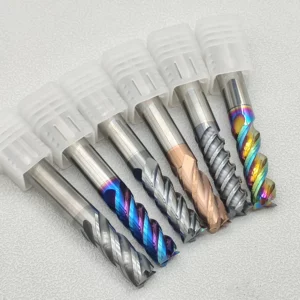Carbide end mill bits play a vital role in various industries, including manufacturing, engineering, and construction. These cutting tools are designed to efficiently remove material from workpieces, making them essential for shaping, milling, and drilling operations. When it comes to selecting the right peu de fraise en bout de carbure, there are several factors to consider.
One crucial aspect to examine is the material of the end mill bits. Carbide, a compound of carbon and other elements, is widely regarded as one of the most durable and robust materials for cutting tools. Its hardness and wear resistance make it capable of withstanding heavy loads and prolonged use. Carbide end mill bits are highly preferred due to their ability to maintain sharp edges for a longer period, resulting in improved performance and reduced downtime.
Another vital consideration is the type of coating on the carbide end mill bits. Coatings are essential for enhancing tool life, reducing friction, and preventing material buildup. Various coating options are available, including TiN (titanium nitride), TiCN (titanium carbonitride), and TiAlN (titanium aluminum nitride). TiN coatings offer excellent heat resistance and low friction, making them suitable for general-purpose applications. TiCN coatings provide enhanced wear resistance, while TiAlN coatings excel in high-speed machining and perform well on hardened materials. By considering the specific needs of your application, you can select the most suitable coated carbide end mill bits.
The flute count is another factor to take into account. Flutes are the spiral channels on the surface of the end mill bit that facilitate chip removal. The number of flutes affects the chip load and the efficiency of material removal. End mill bits with fewer flutes can evacuate chips quickly, making them suitable for high-speed cutting, while those with more flutes result in smoother surface finishes. Depending on your application requirements, you can choose carbide end mill bits with varying flute counts, such as two, four, or even more.
Next, consider the end mill bit geometry. The shape and design of the cutting edges impact the cutting performance and the type of materials they can effectively machine. For example, a square end mill bit offers versatility and is suitable for general milling tasks, while a ball nose end mill bit is ideal for contouring and 3D machining. By understanding the specific requirements of your project, you can select the right geometry for your carbide end mill bits.
Furthermore, look for carbide end mill bits with excellent chip evacuation capabilities. Efficient chip flow is critical to prevent chip clogging, tool damage, and poor surface finishes. Some end mill bits feature specialized chip breakers or flutes designed to optimize chip evacuation, ensuring smooth operation and reducing the risk of premature tool wear.
Considering the application area is also crucial when choosing carbide end mill bits. Different industries and materials require specific cutting tools to achieve optimal results. Whether you are working with aluminum, steel, or other materials, make sure the end mill bits you choose are designed for the particular application. This will ensure the longevity and effectiveness of the tool, ultimately saving you time and money.
In conclusion, choosing the right carbide end mill bits requires careful consideration of various factors. From the material and coating to the flute count and geometry, each aspect plays a vital role in the performance and longevity of the cutting tool. By understanding your application requirements and selecting the appropriate carbide end mill bits, you can achieve exceptional results, improve productivity, and ensure a cost-effective solution for your machining needs.
